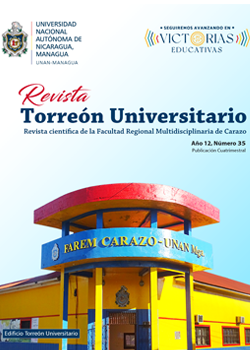Planes curriculares 2013-2021 de UNAN-Managua: análisis en el marco de la continuidad de grado en posgrado
DOI:
https://doi.org/10.5377/rtu.v12i35.17006Palabras clave:
Continuidad, Elementos conceptuales, Extensión, Formación de grado y posgrado, InvestigaciónResumen
Es incuestionable que el sistema de Educación Superior en Nicaragua y, en especial, en la UNAN-Managua ha venido experimentados cambios en su gestión curricular, visión, misión, valores y ejes de trabajo, lo que genera nuevos y desafiantes escenarios. Uno de esos, es la transformación en grado y, por ende, esto implica perfeccionamiento en carreras de posgrado. Para eso fue necesario realizar un análisis documental de los diseños curriculares de las carreras de grado (planes 2013 y 2021) e identificar cómo ocurre la continuidad en la formación de grado en posgrado. El objetivo fue analizar los principales elementos conceptuales de los planes curriculares de las carreras de la UNAN-Managua en el marco de la continuidad de grado en posgrado. La investigación se realizó mediante un enfoque cualitativo, se identificó una unidad de análisis mayor: la continuidad del grado en el posgrado, y menores: elementos conceptuales de los planes curriculares 2013 y 2021 en función de continuidad de formación de grado en posgrado; perfeccionamiento curricular y vinculación de grado en posgrado. Para el análisis de los datos se elaboró matriz de doble entrada. También, se aplicó triangulación de la información, considerando los objetivos, preguntas de investigación y unidades de análisis. En este artículo se presenta una descripción de elementos esenciales de ambos planes desde una óptica central; elementos que los unen y discrepan, aplicación en actividades diarias o gestión curricular y su relación con las carreras de posgrado, así como la coherencia entre los procesos de formación e investigación con relación a la continuidad de competencias de grado hacia posgrado y el desarrollo de líneas de investigación en ambos niveles.
Descargas
289
VISOR 0
HTML 0
PDF (English) 67
HTML (English) 11
Citas
Ary, D. (1990). Introducción a la investigación en educación. Nueva York: Holt, Rinehart and Winston, Inc.
Balestrini, P. (2006). Problemas de Investigación . Venzuela.
Baxter, E. (2003). El proceso de investigación en la metodología cualitativa. El enfoque participativo y la investigación en acción. Metodología de la investigación educativa: desafíos y polémicas actuales. Felix Varela.
Best, A. (1972). Investigación educativa: enfoques cuantitativos, cualitativos y mixtos . Argentina: Sage.
Bunge, M. (1998). La Investigación científica. . Buenos Aires: Ariel.
Cazares, M. (2012). Una reflexión teórica del currículum y los diferentes enfoques curriculares. http://www.colombiaaprende.edu.co/html/mediateca/1607/article-170863.html
Escobar, Á. A. (16 de Octubre de 2016). Esquemas de aprendizaje de la gamática. Mangua.
Gaitán, J., & Puñuel, J. (1999). Metodología General. Conocimiento científico e investigación en la comunicación social. Madrid: Síntesis.
Hernández, R., Fernández, C., & Baptista, P. (2010). Metodología de la Investigacion. Mexico: McGrawHill.
Hernández, R., Fernández, C., & Baptista, P. (2010). Metodología de la Investigacion. Mexico: McGrawHill.
Kerlinger, F. (1997). Investigación del comportamiento. Técnicas y Metodología . . México, D.F: Interamericana.
Latorre, A. (2003). Investigacion Accion. . Barcelona: GRAO.
Lawsy, K., & McLeod, R. (05 de Junio de 2010). Case study and grounded theory: Sharing some alternative qualitative research methodology with systems professionals. Artículo presentado a la 22nd International Conference of Systems Dynamics., 29.
Monja, M. (1993). Programa de enseñanza de habilidades de interactivas (4ta ed.). Madrid: CEPE.
Piñuel, R., & Gaitán, C. (1999). Investigación, comunicación y universidad. Salamanca: Comunicación Social.
Restrepo, B. (1997). Investigación en Educación. Programa de Especialización en Teoría, Métodos y Técnicas de Investigación Social. . Bogotá, Colombia: Santafé de Bogotá.
Salatino, D. (2009). Semiótica de los sistemas reales. Análisis semiótico de la emergencia psico-bio-socio-cultural. México.
Serbia. (2007). Diseño, muestreo y análisis en la investigación cualitativa. Hologramática.
Serbia. (2007). Diseño, muestreo y análisis en la investigación cualitativa. . Hologramática.
Solís. (18 de Octubre de 2003). El análisis documental como eslabón para la recuperación de información y los servicios. Obtenido de http://www.monografias.com/ trabajos14/analisisdocum/analisisdocum.shtml
Tusón, A. (1999). Análisi de la conversa. . Barcelona: Ariel.
UNAN,Managua. (02 de Septiembre de 2011). Modelo Educativo,Normativa y Metodología para la Planificación Curricular. Managua, Nicaragua.
UNAN,Managua. . (02 de Septiembre de 2016). Modelo Educativo,Normativa y Metodología para la Planificación Curricular. Managua, Nicaragua.
UNAN-Managua. (2013). Malla curricular de la carrera Contaduría Publica y Finanzas. Managua, Nicaragua.
UNAN-Managua. (06 de Agosto de 2015). Modelo Educativo, Normativa y Metodología para la Planificación Curricular 2011. Managua, Nicaragua.
UNAN-Managua. (23 de Abril de 2021). Diseño Curricular para Desarrollar Competencias en la UNAN-MANAGUA. Managua, Niacargua. Universidad Nacional Autónoma de Nicaragua, Managua. (23 de Abril de 2021). Managua, Nicaragua.
UNAN-Managua. (26 de Noviembre de 2021). Normativa de pràctica de formación profesional (PFP) y pasantías . Managua, Nicaragua: UNAN-Managua.
Descargas
Publicado
Cómo citar
Número
Sección
Licencia
Derechos de autor 2023 Universidad Nacional Autónoma de Nicaragua, Managua

Esta obra está bajo una licencia internacional Creative Commons Atribución-NoComercial-SinDerivadas 4.0.
Los autores que publican en esta revista están de acuerdo con los siguientes términos.
- El autor o los autores de los artículos, ensayos o investigaciones conceden a la Universidad Nacional Autónoma de Nicaragua, Managua (UNAN-Managua) los derechos de edición (copyright) del trabajo enviado, por consiguiente la Universidad cuenta con el derecho exclusivo para publicar el artículo durante el periodo completo de los derechos de autor.
- Estos derechos de autor/ autores autorizan a la Revista Torreón Universitario y a la Universidad editar y divulgar/publicar el artículo en dicha Revista, incluyendo reproducción impresa y electrónica, el almacenamiento, recuperación y cualquier otro tipo de publicación, y fuentes de información secundaria como servicios de resúmenes y bases de datos, así mismo la facultan a proteger el artículo contra el uso no autorizado para su difusión por medios impresos o electrónicos (PDF, HTML, EPUB, XML u otros).
Licencia para el uso del contenido
La revista hace uso de la Licencia Creative Commons Atribución-NoComercial-SinDerivar 4.0 Internacional.
Bajo esta declaración:

Este revista está sujeta a una licencia de Creative Commons Reconocimiento-NoComercial-SinObraDerivada 4.0 Internacional. Puede ser copiada, distribuida y transmitida públicamente siempre y cuando se cite al autor y la fuente (Revista Torreón Universitario), no debe modificarse ni utilizarse con ningún fin comercial. La licencia completa se puede consultar en http://creativecommons.org/licenses/by-nc-nd/4.0/.



